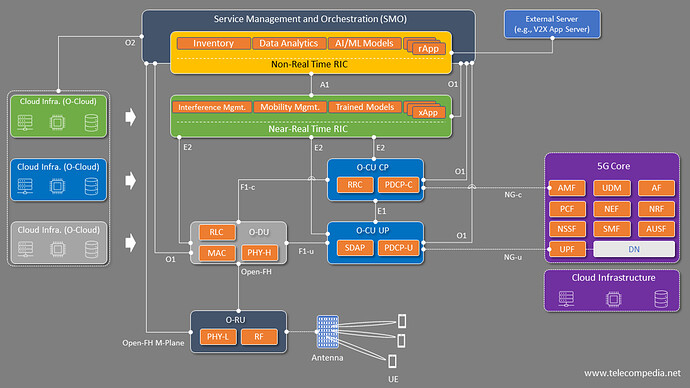-
My friend: Hi Ibrahim, I am confused

- Me: Why?
-
My friend: When I am checking the Open RAN architecture, I always wonder why we have two RICs? Isn’t one RIC enough?
- Me: RIC (RAN Intelligent Controller) is a software-defined component of the Open RAN architecture suggested by the O-RAN Alliance as it was not existing in the 3GPP standards. We have two types of RIC: near-RT RIC and non-RT RIC. Both are used to bring intelligent control and automation to the RAN using AI and ML. Near-RT RIC can be deployed centrally or on the network edge, often within a telco edge cloud or regional cloud, to meet the latency requirements for near-RT operations which is from 10ms up to 1sec. While non-RT RIC operates centrally within the operator’s network as part of the SMO framework and so it handles functions with a response time greater than 1sec. Both host specialized applications for automation and optimization of the RAN which are xApps and rApps for near-RT and non-RT RICs respectively.
-
My friend: So, how are the two RICs interacting together?
- Me: The placement of the non-RT RIC in the SMO provides access to external sources of information that are not available to the RAN nodes or the near-RT RIC. So, non-RT RIC communicates with the near-RT RIC’s xApps to provide policy-based guidance and assists in RAN optimization, while near-RT RIC receives policy guidance from the non-RT RIC and provides policy feedback to the non-RT RIC. For example, the non-RT RIC can provide information about weather conditions to the near-RT RIC, so that the near-RT RIC can ask the RAN nodes (CU& DU) to change the behavior, such as prioritizing frequencies that are less affected by rainy conditions and then feedback the non-RT RIC. Also, data about opening and closing times at a shopping mall, which is an input to the non-RT RIC, could be used to determine when to power-up or power-down indoor small cells, which is the info that non-RT RIC will send to near-RT RIC, then near-RT RIC will ask the RAN nodes to optimize the energy as these cells won’t be utilized after the mall shuts and everyone goes home.
-
My friend: So, all Open RAN vendors are implementing the two RICs, right?
- Me: No. I know that this is a surprising info, but this is the fact. Samsung and Ericsson declared their interest in non-RT RIC more than near-RT RIC and are trying to integrate non-RT RIC inside their SMO offerings. They claim that near-RT RIC is doing control in the same range of time as CU which can make conflicts between both of them. Moreover, they think that the new types of data coming to non-RT RIC will help to add value to optimize the network more than the traditional info from the RAN side which is used in near-RT RIC. However, other vendors such as Nokia, Rakuten Symphony, and Mavenir are investing in both types of RICs.
-
My friend: Thanks a lot.
- Me: You are welcome.
LinkedIn: ![]()
